Foundation repair: reconstruction options and reinforcement methods
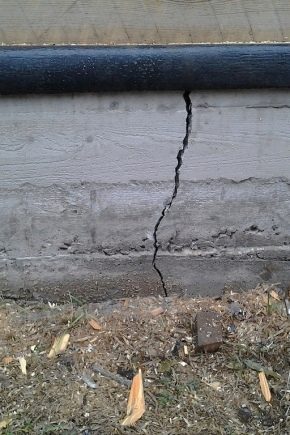
The construction of any capital building begins with the foundation. If it is not laid correctly, then the fortress of the structure will be in jeopardy, and troubles will soon begin. Problems with the foundation can be for a variety of reasons, but it is important to identify and solve them in time, otherwise it can be life-threatening for those who will be in the emergency house.

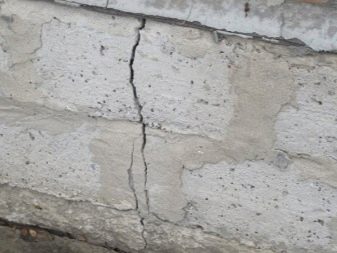
Causes of destruction
Any house built on a foundation can serve for quite a long time, but in some cases, ego exploitation can be significantly reduced if cracks are found in the base. The beginning of destruction can lead to cracks on the walls, which, in turn, can cause the complete collapse of the structure.
To prevent this from happening, it is important to react in time to any changes in the foundation, especially when it comes to the old building.
If any cracks are identified, it is necessary to trace the dynamics of their increase. If it is, then it is necessary to urgently intervene and repair the problem area. If the cracking was one-time and no longer moves, then it is enough to eliminate it, and in the future there will be no problems. The easiest way to find out about the nature of the damage is with the help of gypsum beacons: they are superimposed on the right place across the crack, then several days are expected. After two or more days, you can evaluate the result - if the lighthouse is intact, then everything is in order, cosmetic repairs are needed.
If the damage is serious, and there are breaks in the lighthouse, then it is important to urgently start restoring the normal appearance of the base under the house.

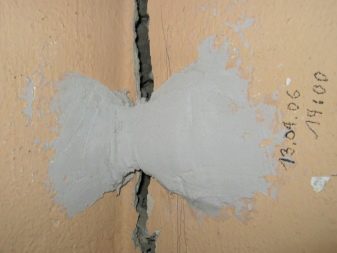
In order for such situations not to recur, it is also necessary to determine why the destruction of the foundation began, what reason influenced it. Several factors are most likely.
- An increase in the mass of the building, which was originally much smaller. All kinds of extensions, the organization of the second floor or attic can add that weight that the foundation is not ready to withstand.
- Ground movement due to natural phenomena. Summer heat, autumn-spring rains and winter cold cause an increase and decrease in the size of the soil, which from year to year affect the foundation, and sooner or later can seriously deform it.
- Problems associated with the violation of the waterproofing system, which should be laid even during the formation of the foundation.
- Emergency situations due to the use of communications. This can be a rupture of a pipeline with water or sewage, which will make it possible for a large amount of liquid to affect the base of the house, destroying it.
- There may be too much groundwater. Without studying the features of the soil and the groundwater lying under it, you can build a house on an unsuitable territory, which will cause the rapid destruction of the structure. To avoid this, you can carry out a drainage system under the foundation, but this must be done before construction begins.

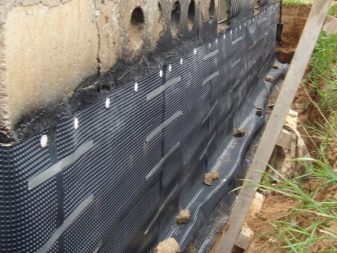

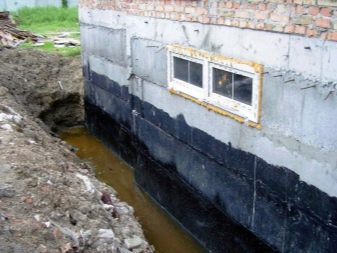
The impact of the soil on which the building is located is of the greatest importance for the integrity of the house, if the foundation interacts with the frozen ground, then during the thawing period its dimensions will change, which will negatively affect the foundation of the building. corrosive substances are thrown out, then they, affecting the soil, negatively affect the concrete from which the foundation is made, weakening it and bringing it to the formation of cracks.
To avoid this, it is necessary not only to remove the source of soil contamination, but also to change the very ground around the house, and strengthen the foundation with brickwork, which has a layer of roofing material between the old product and the new part of the base of the building.
You can also strengthen the problem area with the help of a prefabricated reinforced concrete base, which will become a protective layer and for some time it will be able to withstand all attacks from external factors that were detrimental to the old product. In order not to repeat the same problems, it is advisable to try to minimize the harmful factors that are near the house.
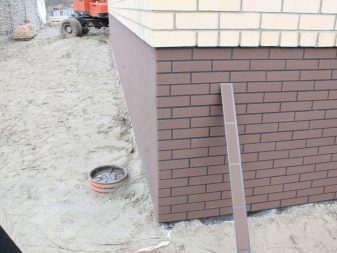
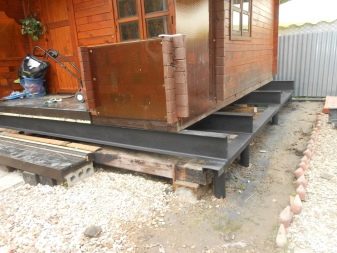
Common defects
Due to the different effects, defects of a very different nature can occur in the foundation.
- An intense impact on some part of the foundation of a building can lead to increased exploitation of one of the sections, which will lead to its faster wear out. This may apply to buildings made of wood, for example, a bathhouse or sauna, which is often used.
- If the foundation of the building is made of bricks, then the impact of the soil itself can destabilize them. There is soil, which swells strongly from the temperature difference, which forces the supports to withstand serious loads, with which they may not be able to cope and warp. Changes in the distribution of the load on the base will cause the active appearance of various kinds of defects on it.
- Subsidence of a part of the foundation, which occurs due to violation of the construction norms of the foundation itself or construction on it. If the foundation for the house is not formed correctly, or the necessary technologies are not applied, then you should not expect a long service life, and problems will begin very soon.
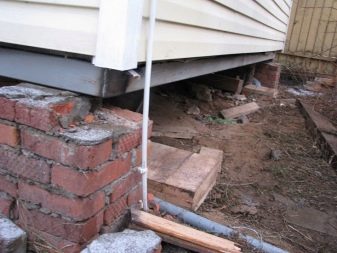
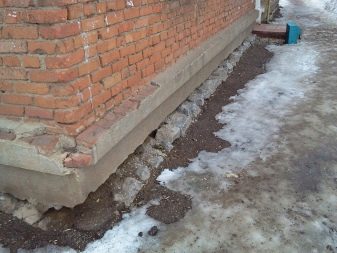
- The influence of atmospheric precipitation on the strength of the foundation is of key importance. Usually this part of the house is erected so that it is almost completely in the ground, but if a significant part is on the surface, then it will have to come into contact with air, sun and moisture in the form of precipitation. The influence of natural resources is especially acute if the structure was flooded in the winter season, in this case it is important not to allow long-term downtime of the foundation. As soon as it becomes durable, you need to start building a house, or at least build a canopy that will not allow external factors to affect the base material.
- When laying a foundation from FBS blocks, problem areas can be detected if the process of erecting the foundation was done incorrectly. One of the blocks can begin to crumble, which leads to an uneven load on the others, and the structure becomes completely fragile.
- If the base for the house is made of bricks, then they can also crack or collapse due to a number of the above reasons.
In this case, it is important to find a problem area and strengthen it, but an equally significant measure will be to search for the causes of such a problem, which will make it possible to avoid a repetition of this situation.
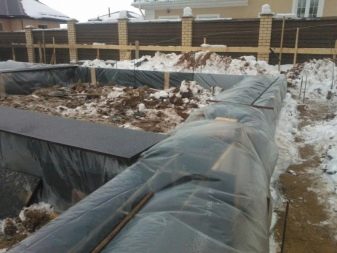
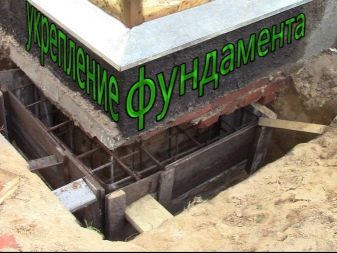
- For buildings erected on piles, it is possible to push these structures out. The reason may be the swelling of the soil, which destabilizes the supports during the first year after the construction of the building. It is important to control this process and keep track of how many supports the house stands on.
- The deformation features of the foundation can have a number of reasons, including: a small supporting area of the foundation; emergency soaking of the soil around the base; the large weight of the foundation itself; construction of a support under the house on those soils that are greatly narrowed by various natural phenomena.
- Deformation of the walls of the foundation can occur for reasons such as low strength of the masonry structure; the congestion of the surface, which is located near the future building; heaving of soil from frost with significant deformations of the soil, which also affect the foundation.
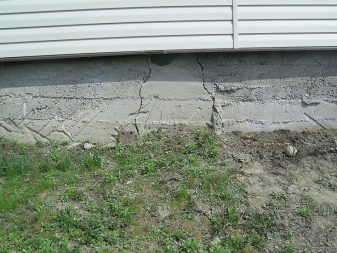
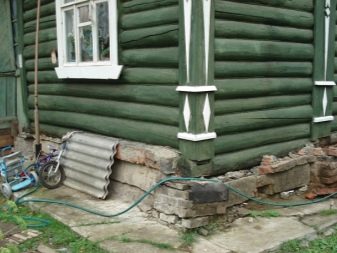
- The process of stratification of masonry from rubble can occur for such reasons as the dressing of the masonry was done incorrectly or it was not done at all; decrease in strength indicators due to long-term operation, frequent exposure to moisture; other aggressive influences; overloading the structure, which will be the support for the house.
- Problems with the side surface of the base can occur when negative factors influence the external part of the structure; the presence of poor-quality waterproofing or its absence at all.
- Breaks in the foundation in height, which may occur due to the fact that the soil swells strongly from the effects of frost. If there are any violations in the technological characteristics in laying the foundation for the house, then such problems cannot be avoided.
- Cracks in the strip foundation slab can appear if the weight of the foundation is too heavy, or reinforcement with a small diameter was laid during its construction.
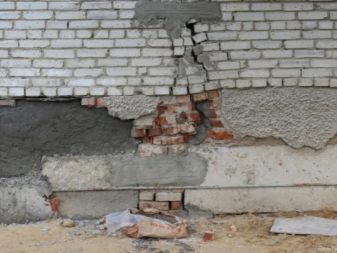
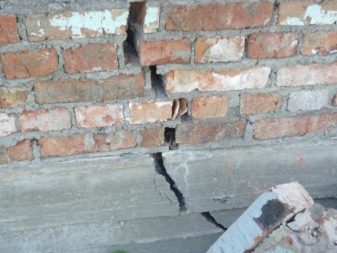
If it was noticed that the house has subsided, then it is worth looking for the reason in the foundation, because the evenness of the building relative to the ground level will depend on its condition. Minor damage is when the base under the building only crumbles a little, in this case it is necessary to strengthen its outer part and analyze the reasons that led to negative results. When there is already a gap in the structure, then you need to act immediately, because further more serious destruction will begin if they are not stopped in time.
When it comes to problems with the foundation of a wooden house, where problem areas have appeared between the basement and the first crown, it is better to process them with bituminous mixtures.
Whatever problems arise with the construction and the foundation on which it stands, it is worth carefully analyzing the object in order to be able to take appropriate repair measures.

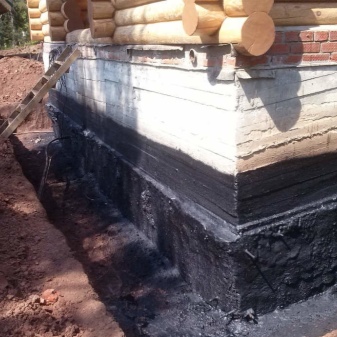
Damage diagnostics
The most common causes of damage to building foundations are precipitation, groundwater and frost. In addition, a number of more specific reasons can be identified:
- violation of the integrity of the waterproofing layer during deformational transformations in the structure itself;
- violation of the properties of waterproofing, which are observed with too long use;
- improper installation or imposition of inappropriate functions on waterproofing;
- cracks in the lining of the basement due to the use of non-frost-resistant materials for this product;
- a high level of groundwater, which is at an unacceptable level, not laid down as permissible during the construction period;
- destruction of backfill near the building or the use of waterproofing too deep, especially if there is no second layer near the basement.
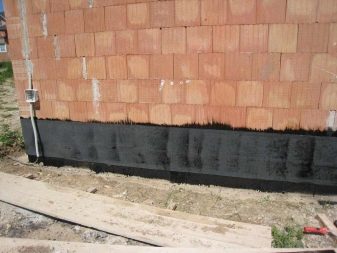
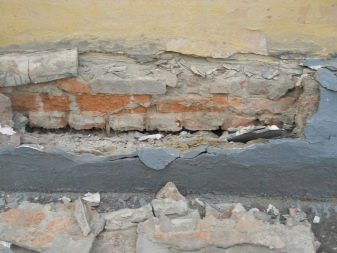
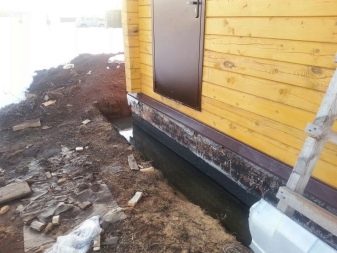
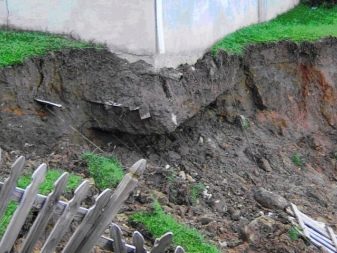
To cope with such damage, it is necessary to introduce new waterproofing under the building to replace the one that can no longer perform its functions normally.
To do this, a hole several bricks high is organized in the basement, where two layers of waterproofing are laid, after which the bricks are returned to their place.
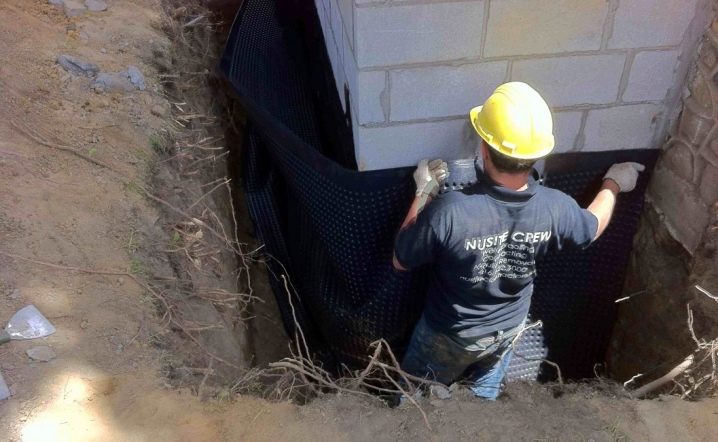
If the destruction of the concrete foundation occurs, then the main reason is the leaching of alkalis or the direct destruction of the material itself. In addition, the reasons may be:
- the influence of too soft water with alkali;
- presence of water and salt near concrete.
To eliminate such problems, it is necessary to minimize the amount of water negatively affecting the construction by laying a drainage system. Next, you need to restore what was damaged and protect the structure from repeating the same negative impact. For this, the soil is excavated to the very base of the foundation, the affected areas are cleaned and the cement-sand mortar is used as a protective layer. In addition, it will not interfere with the construction of a shirt with bricks that have been impregnated with bitumen, and roofing material with asphalt mastic. When the work is finished, the cavity is filled with greasy clay.
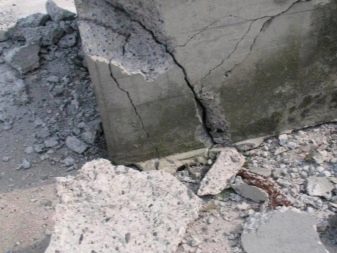
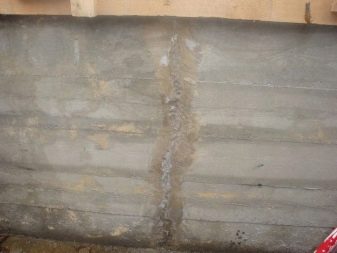
As for the brick foundation, the reasons for the stratification of such a structure may be:
- brickwork without dressing;
- weak indicators of product strength;
- overloading the structure if the house was being completed.
To eliminate such disadvantages, you can expand the foundation or transfer part of the load using outrigger beams, which will help restore the foundation.
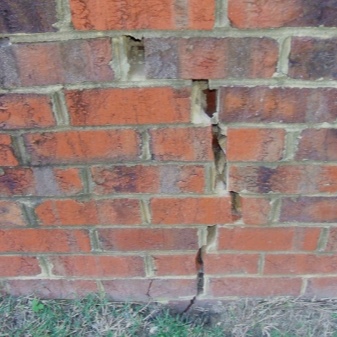
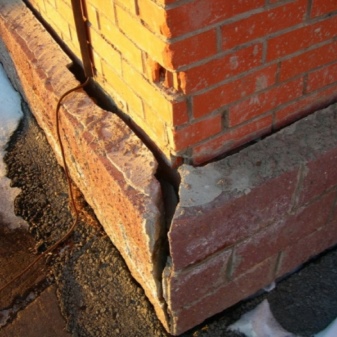
There may also be structural breaks in height, which occur due to frost heaving of the soil.
To fix this and avoid repetition in the future, you need to replace the unsuitable soil with the correct one, which will not behave aggressively during the changing weather. An important step will be the process of restoring the blind area, which can be insulated. If necessary, you can equip drainage channels to drain excess moisture. The sinuses should be covered with drainage material.

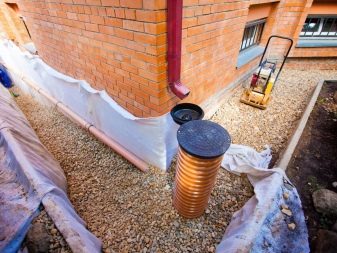
If there are cracks in the strip foundation slab, or the shrinkage process is uneven, then the reasons for this may be:
- the ratio of the size of the step of the foundation sole was chosen incorrectly;
- foundation narrow in width;
- the large weight of the base, for which it was not designed, due to extensions;
- low bearing capacity of the foundation due to constant contact with moisture.
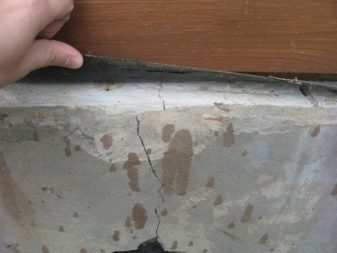
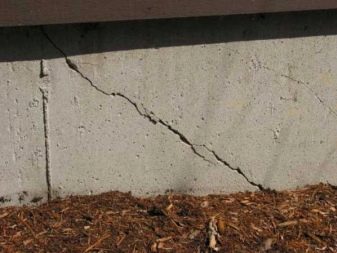
To eliminate such damage, you need to strengthen the base under the house by increasing it. It is important to remove all damage in order to carry out work on the reconstruction of the walls of the building itself, on which small or large cracks often appear. There is no point in doing this work before strengthening the foundation.
As for the stone foundation, then it can be observed layering of masonry and the loss of whole stones, which is typical for rubble foundation. The stones themselves can collapse, which entails deformation of the solution that held them. To solve this problem, it is necessary to find the place of destruction and carry out a series of restoration measures that will return the masonry to its place, and protective measures will prevent it from repeated destruction.
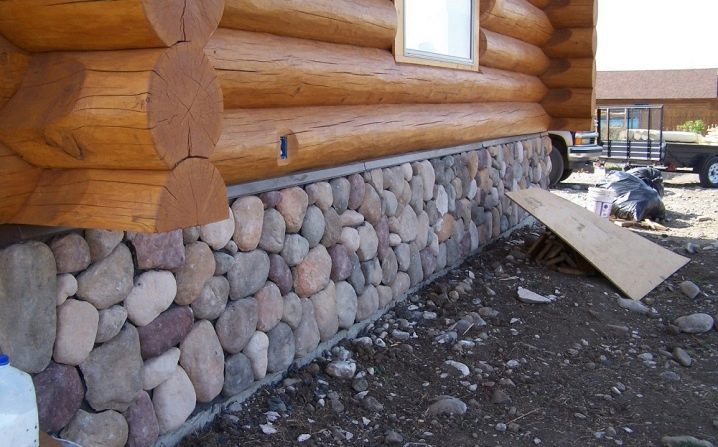
Recovery methods
The restoration of the foundation can be done by hand, although the essence of the work is rather complicated and requires knowledge of certain rules. First of all, you need to understand how active the destruction is, and, depending on this, choose the option for restoring the structure. To do this, you will need to apply plaster strips, which, after hardening, will be able to clarify all the nuances. In the event of a crack in such a lining, it is necessary to carry out immediate repairs to the foundation so that destruction does not go to the walls of the building. If the plaster remains in place and has not received any damage, then you just need to remove the cracks by carrying out cosmetic measures.
It is possible to fill the gaps with cement mortar, which will hold the entire structure for some time, but sooner or later you will still have to change the support.
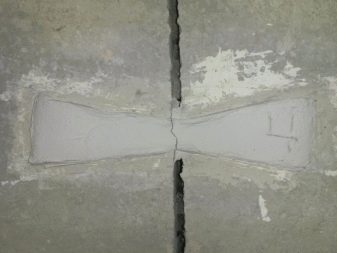
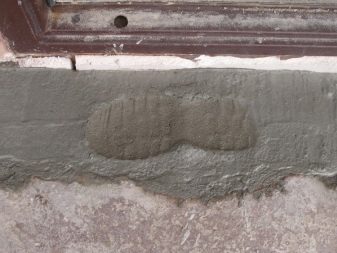
If you can do without this, then pouring will be the best option, since it can be carried out without lifting the building or any other more serious actions with the support. For those situations where destruction began everywhere, it is necessary to reconstruct the entire foundation. To do everything right, you need step-by-step instructions that indicate the correct sequence of actions.
- The excavation of the base of the building is carried out with the help of shovels, with which parts of the land are freed from the ground adjacent to the foundation. It is important to dig at a 35 degree angle.
- The surface on which the restoration will be carried out must be completely free of any contamination. It is necessary to remove the old material and clean all the cracks well.
- Treat problem areas with a deep action primer that will later help better contact the cement.
- After all the measures taken, holes must be drilled in the foundation, which must go through the base and be spaced 60 cm apart. For optimal effect, you need to make several rows of such holes, from two to four.

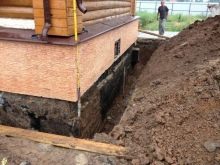
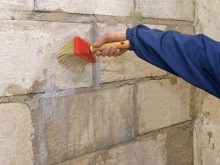
- The next step is to use anchors to which the reinforcement is welded.Thus, you can get a high-quality formwork, on which further actions will be carried out. It is important to apply an anti-corrosion mixture to the joints of the reinforcement so that the product will last longer.
- You need to install a mesh on the reinforcement, which can be made yourself, or a simpler version of the chain-link is chosen. It is on its surface that the insulation and waterproofing layers are organized. Such measures reduce the impact of adverse factors, and the reinforced base under the house will last much longer.
- In the organization of waterproofing, you can use a simple film, which is used both in the arrangement of drainage and in the laying of the sewage system, and the mastic will help to secure it securely.
- The next stage involves pouring the formwork using concrete mortar. To save some of the mortar, you can add stones or debris to it.
- Waiting for the moment until the area to be restored is completely dry, after which everything can be buried.


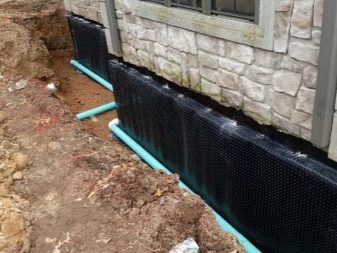

If you need to repair the foundation of an old house made of wood or a panel structure, then you need to use a different technique.
For which only two options are suitable:
- lifting the base and installing it on a new structure;
- complete change of the foundation.
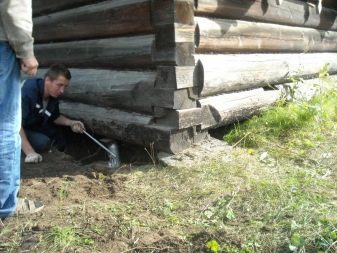

If the foundation of the building is equipped with screw piles, then its repair will take place in a special way.
- A wooden house installed on such a foundation can simply be lifted and renovated, but it is important to do it right. You shouldn't rent the whole house at once, you need to carry out this process in parts.
- The first step is to open the ground near one support, while having pipes for supports or a jack in the location.
- In the case of a pile foundation, the best solution for work will be a cement-lime mortar, which must be poured under the blind area.
- After one pile has solidified, you can continue working with the second. It is important to carry out reconstruction work only on one pile and no more.
- After that, you can fill in the additional formwork, or put the chain-link at the bottom of the posts.
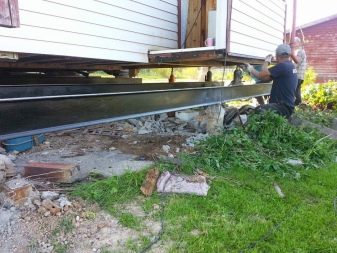
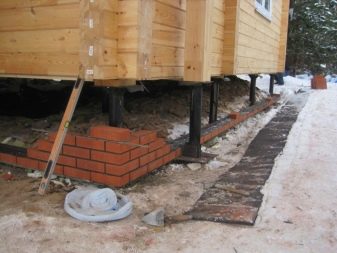
There is another option for the reconstruction of such foundations, which involves the use of a reinforcing mesh, that is, crowns that are placed over the entire foundation and welded. Any problem areas can be redone, the main thing is to learn how to carry out the process itself correctly, without violating its basic laws.
Strengthening the foundation
Since the foundation is the main structure that holds the entire structure on itself, its condition must always be complete, without significant damage and violations of integrity, otherwise this will entail problems of a much more serious nature. It is sediment or serious cracks that can cause partial or complete destruction of a building, and if it is residential, then this is a huge danger to the people who inhabit it.
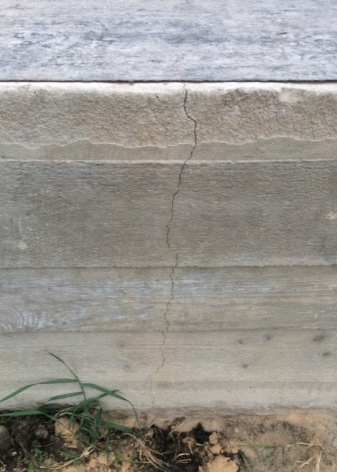

Since the installation of foundations under buildings has been used for a very long time, they also learned to deal with the problems that can occur. The principle is that a new one is laid around the old foundation, which strengthens it and does not allow it to collapse in the future. The main stages of such work are reduced to several actions.
- Digging earth in the corners of the house where the foundation is. It is important that these pits are square. The depth and width of the hole should be one meter by one meter. It is important to go deep at least half a meter lower than the existing structure that needs to be restored.
- Manufacturing of reinforcing cages, which should be as many as there are corners in the house. If the problems are serious, it is better to use reinforcement along the entire length of the building wall.
- The next stage is the installation of metal structures in the dug holes and pouring them with concrete.
It is important to choose a grade for the mortar that will guarantee the greatest strength of the finished structure.
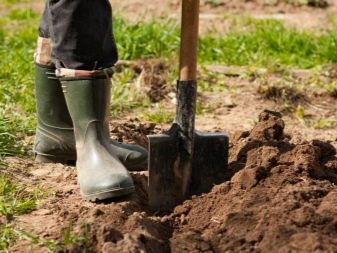
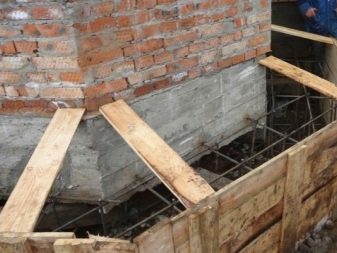
It is advisable to make the process of digging holes sequential, and carry out the work in stages so that open areas do not come into contact with the environment for too long, which will have a detrimental effect on them. As soon as the pit filled with concrete has dried, you can start working with the second corner, it is important to check the condition of the base, on which the integrity of the foundation will depend.
As for a wooden house, it is much more difficult to work with it. The problem is that the crown of such a building very often rotts and collapses, which greatly interferes with the process of restoring the foundation. Before starting to work with the foundation, it is necessary to replace the log house at the bottom of a private house, so that the finished building will withstand further repair work and after them will serve for many more years.
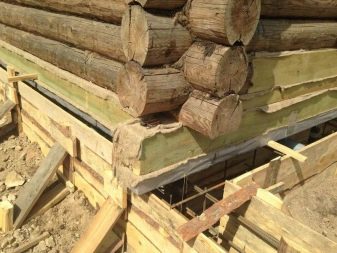
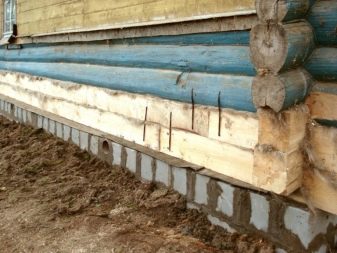
If work is to be done to strengthen the foundation of a country wooden house, then it is important to have a clear sequence of actions.
- At first have to disassemble the base of the house, which will be the beginning of work aimed at strengthening the entire building. It is necessary to partially disassemble the foundation in the area of the lower log in order to have access to those boards that will be replaced. In the part where the rotten tree comes into contact with the normal one, you will need to make a saw cut.
- The second stage involves carrying out reconstructive actions around the entire perimeter of the house... After replacing the wooden part of the building, the disassembled foundation element must also be renewed. Only after one side is completely ready, you can move on to the next wall. It is in this sequence that the work is going on. Replacing the crown of a wooden house is not an easy task, because you need to remove as many as two rows, installing a new tree in their place, while impregnating it with a composition that will serve as protection against all kinds of negative influences and a layer of waterproofing for additional protection.
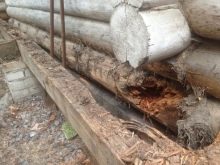
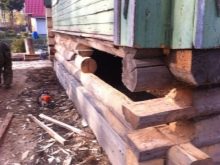
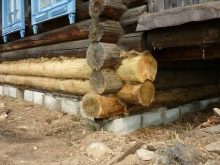
- The next stage involves activities for unloading the hut, for which it is necessary to remove everything heavy that is in it from the house. This is done in order to be able to reinforce the foundation in relatively comfortable conditions. If possible, it is better to remove from the building even doors with a floor, which have a considerable total weight.
- Foundation opening activities, involving digging holes that will be placed at a distance of two meters from each other, and place channels in them, but you can use I-beams. With the help of these structures, you can raise the house to the height at which you can qualitatively strengthen the foundation.
Supports are temporarily built on which the house stands, and at this time all the main work is being done, after which the house is lowered and everything returns to its place.


Whatever the problems associated with the integrity of the foundation, they need to be addressed and done in a timely manner and correctly.
For the foundation repair technology, see the next video.













The comment was sent successfully.